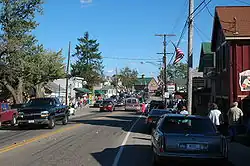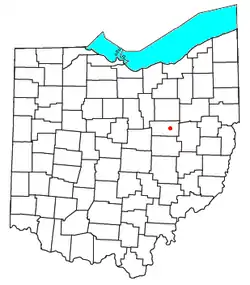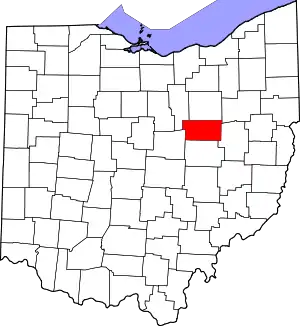Berlin, Ohio | |
|---|---|
 Downtown Berlin | |
 Location of Berlin, Ohio | |
| Coordinates: 40°33′40″N 81°47′40″W / 40.56111°N 81.79444°W | |
| Country | United States |
| State | Ohio |
| County | Holmes |
| Township | Berlin |
| Area | |
| • Total | 3.83 sq mi (9.91 km2) |
| • Land | 3.82 sq mi (9.89 km2) |
| • Water | 0.01 sq mi (0.02 km2) |
| Elevation | 1,285 ft (392 m) |
| Population (2020) | |
| • Total | 1,447 |
| • Density | 378.89/sq mi (146.31/km2) |
| Time zone | UTC-5 (Eastern (EST)) |
| • Summer (DST) | UTC-4 (EDT) |
| ZIP code | 44610 |
| Area code | 330 |
| FIPS code | 39-05816 |
| GNIS feature ID | 1048519 |
Berlin is an unincorporated community and census-designated place in central Berlin Township, Holmes County, Ohio, United States.[2] As of the 2020 census it had a population of 1,447.[3] Located in Ohio's Amish Country, the village is part of a large regional tourism industry.[4]
History

| Census | Pop. | Note | %± |
|---|---|---|---|
| 2010 | 898 | — | |
| 2020 | 1,447 | 61.1% | |
| 2010[5] and 2020[3] | |||
The village of Berlin–the oldest existing village in Holmes County–was first planned on July 2, 1816, by John Swigert, a native of Berlin, Germany. Swigert's plan provided for 108 lots to be arrayed along two streets, one north-south and the other east-west. Another early settler, Joseph Troyer, hailed from Berlin, Pennsylvania, and together Swigert and Troyer bestowed upon the new settlement the shared name of their respective home towns. Berlin is located at a high point in Holmes County, and local legend holds that Swigert chose the site because, thus situated, the town could be more readily defended against Indian attack.
A large share of the early settlers of the Berlin area were of German or Swiss ancestry and came to Ohio from Pennsylvania.
In 1818, a school was established in Berlin and in 1822 a post office.[6] These were soon followed by Methodist, Presbyterian, Baptist and Mennonite churches. Later, Amish settlers began to arrive. Berlin enjoyed commercial and industrial growth, and during the 19th century was home to machine shops, a foundry, blacksmith shops, a hat factory, hotels, an auction house, and a variety of retail establishments.[7] Berlin was described in 1833 as having 21 residential houses, two stores, two taverns and a physician.[8]
Today, Berlin is in the center of Ohio's largest Amish community and is home to the Amish and Mennonite Heritage Center, featuring the Amish and Anabaptist history cyclorama, Behalt.[9][10] Ohio has about 56,000 Amish residents, an increase of 60 percent since 1992.[11]
Geography
Berlin is situated in east-central Holmes County at the junction of U.S. Route 62 and State Route 39. US-62 leads northeast 11 miles (18 km) to Wilmot, and State Route 39 leads southeast 10 miles (16 km) to Sugarcreek. Together, the two highways lead west 7 miles (11 km) to Millersburg, the Holmes county seat.
Berlin is located at latitude 40° 33' 40" north and longitude 81° 47' 40" west. The ZIP code is 44610 and the FIPS place code is 05816. The elevation ranges from 1,200 to 1,280 feet (370 to 390 m) above sea level.
Economy
More tourists visit Berlin, permanent population 685, than any other town in Ohio Amish Country.[12]: 83 Berlin was the first town in Ohio to market the Amish to tourists.[12]: 83 Berlin's business district is large, with as of 2012 more than 40 shops, 10 hotels, and multiple restaurants large and small.[12]: 85 Amish county analyst Susan L. Trollinger calls its architecture and offerings "eclectic" but dominated by the American frontier and the 1950s and points out that like Walnut Creek, all call back to the past.[12]: 88, 106 Trollinger argues that the frontier theme in Berlin presents a story of peaceful people leaving crowded cities behind in order to make a better life for themselves and their families.[12]: 94 The community is home to the Amish and Mennonite Heritage Center.
Notable people
- Atlee Pomerene, U.S. senator
- Nate Torrence, television actor
- Alta Weiss, early semiprofessional female baseball player
See also
References
- ↑ "ArcGIS REST Services Directory". United States Census Bureau. Retrieved September 20, 2022.
- ↑ U.S. Geological Survey Geographic Names Information System: Berlin, Holmes County, Ohio
- 1 2 Census 2010 vs. 2020 comparison
- ↑ Walle, Randi (May 31, 2018). "Explore Ohio Amish Country". Columbus Underground. Archived from the original on September 23, 2020. Retrieved August 18, 2021.
- ↑ "Geographic Identifiers: 2010 Census Summary File 1 (G001): Berlin CDP, Ohio". American Factfinder. U.S. Census Bureau. Archived from the original on February 13, 2020. Retrieved January 9, 2018.
- ↑ Gallagher, John S. and Patera, Alan H. The Post Offices of Ohio. The Depot, 1979, p. 129.
- ↑ "Area History". Berlin Village Info. Berlin Main Street Merchants. Archived from the original on October 5, 2011. Retrieved October 7, 2011.
- ↑ Kilbourn, John (1833). The Ohio Gazetteer, Or a Topographical Dictionary. Scott and Wright. pp. 93. Retrieved December 12, 2013.
- ↑ "Amish and Mennonite Heritage Center". Retrieved March 6, 2022.
- ↑ Russo, Valerie (November 4, 2006). "Life in the slow lane: Ohio, not Pennsylvania, is home to the most Amish people". The Patriot Ledger.
- ↑ Zachariah, Holly; Josh Jarman (August 23, 2008). "Amish Population is Growing, Shifting". The Columbus Dispatch. Archived from the original on October 22, 2010. Retrieved October 25, 2008.
- 1 2 3 4 5 Trollinger, Susan L. (2012). Selling the Amish : the tourism of nostalgia. Baltimore: Johns Hopkins University Press. ISBN 978-1-4214-0467-7. OCLC 823654526.
